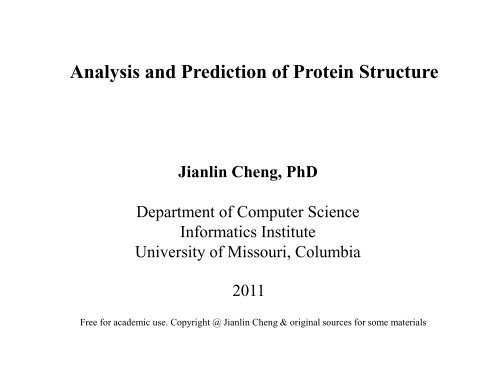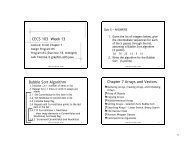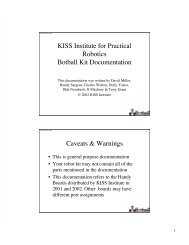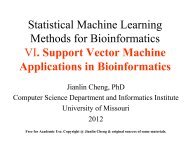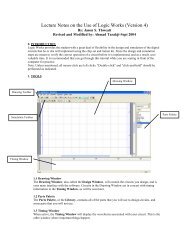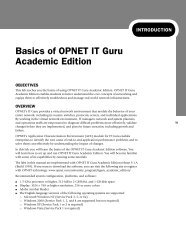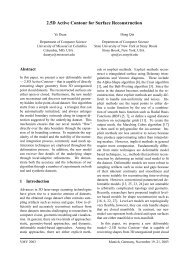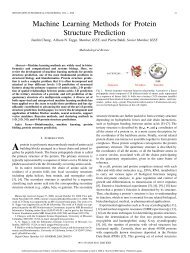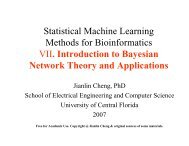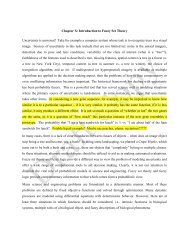Analysis and Prediction of Protein Structure - Eagle.cs.missouri.edu ...
Analysis and Prediction of Protein Structure - Eagle.cs.missouri.edu ...
Analysis and Prediction of Protein Structure - Eagle.cs.missouri.edu ...
Create successful ePaper yourself
Turn your PDF publications into a flip-book with our unique Google optimized e-Paper software.
<strong>Analysis</strong> <strong>and</strong> <strong>Prediction</strong> <strong>of</strong> <strong>Protein</strong> <strong>Structure</strong><br />
Jianlin Cheng, PhD<br />
Department <strong>of</strong> Computer Science<br />
Informati<strong>cs</strong> Institute<br />
University <strong>of</strong> Missouri, Columbia<br />
2011<br />
Free for academic use. Copyright @ Jianlin Cheng & original sources for some materials
Outline<br />
I. Sequence, <strong>Structure</strong>, Function Relation<br />
II. Determination, Storage, Visualization<br />
III. <strong>Structure</strong> Classification<br />
IV. 1D <strong>Prediction</strong><br />
V. 2D <strong>Prediction</strong><br />
VI. 3D <strong>Prediction</strong><br />
VII. Useful Tools
Sequence, <strong>Structure</strong> <strong>and</strong> Function<br />
AGCWY……<br />
Cell
Amino Acid <strong>Structure</strong>
Amino Acids<br />
Hydrophilic
<strong>Protein</strong> Sequence<br />
N<br />
A directional sequence <strong>of</strong> amino acids/residues<br />
…<br />
C<br />
Amino Acid 1 Amino Acid 2<br />
Peptide bond<br />
Side Chain<br />
Backbone
<strong>Protein</strong> Secondary <strong>Structure</strong><br />
• Determined by<br />
hydrogen bond<br />
patterns<br />
• 3-Class categories:<br />
alpha-helix, betasheet,<br />
loop (or coil)<br />
• First d<strong>edu</strong>ced by Linus<br />
Pauling et al.
Alpha-Helix<br />
Jurnak, 2003
Beta-Sheet<br />
Anti-Parallel<br />
Parallel
Non-Repetitive Secondary <strong>Structure</strong><br />
Beta-Turn<br />
Loop
Tertiary <strong>Structure</strong><br />
• John Kendrew et al.,<br />
Myoglobin<br />
• Max Perutz et al.,<br />
Haemoglobin<br />
• 1962 Nobel Prize in<br />
Chemistry<br />
Perutz<br />
Kendrew
myoglobin<br />
haemoglobin
Anfinsen’s Folding Experiment<br />
• <strong>Structure</strong> is uniquely<br />
determined by protein<br />
sequence<br />
• <strong>Protein</strong> function is<br />
determined by protein<br />
structure
<strong>Protein</strong> Folding Movie<br />
• http://www.youtube.com/watchv=fvBO3T<br />
qJ6FE&feature=fvw (Demo)
Outline<br />
I. Sequence, <strong>Structure</strong>, Function Relation<br />
II.<br />
III.<br />
IV.<br />
Determination, Storage, Visualization,<br />
<strong>Analysis</strong>, <strong>and</strong> Comparison<br />
<strong>Structure</strong> Classification<br />
1D <strong>Prediction</strong><br />
V. 2D <strong>Prediction</strong><br />
VI.<br />
3D <strong>Prediction</strong><br />
VII. Useful Tools
<strong>Protein</strong> <strong>Structure</strong> Determination<br />
• X-ray crystallography<br />
• Nuclear Magnetic Resonance (NMR)<br />
Spectroscopy<br />
• X-ray: any size, accurate (1-3 Angstrom<br />
(10 -10 m)), sometime hard to grow crystal<br />
• NMR: small to medium size, moderate<br />
accuracy, structure in solution
Wikipedia, the free encyclopedia
Pacific Northwest National Laboratory's high magnetic field (800 MHz,<br />
18.8 T) NMR spectrometer being loaded with a sample.<br />
Wikipedia, the free encyclopedia
Storage in <strong>Protein</strong> Data Bank<br />
Search protein 1VJG
<strong>Structure</strong> Visualization<br />
• Rasmol<br />
(http://www.umass.<strong>edu</strong>/microbio/rasmol/getras.ht<br />
m)<br />
• MDL Chime (plug-in)<br />
(http://www.mdl.com/products/framework/chime/)<br />
• <strong>Protein</strong> Explorer<br />
(http://molvis.sdsc.<strong>edu</strong>/protexpl/frntdoor.htm)<br />
• PyMol
J. Pevsner, 2005
Outline<br />
I. Sequence, <strong>Structure</strong>, Function Relation<br />
II.<br />
III.<br />
IV.<br />
Determination, Storage, Visualization, <strong>and</strong><br />
Comparison<br />
<strong>Structure</strong> Classification<br />
1D <strong>Prediction</strong><br />
V. 2D <strong>Prediction</strong><br />
VI.<br />
3D <strong>Prediction</strong><br />
VII. Useful Tools
<strong>Protein</strong> <strong>Structure</strong> Classification<br />
• About 4 million known protein sequences<br />
• About 40,000 known protein structures in PDB<br />
• Many protein structures are similar due to<br />
evolutionary relationship<br />
• Many protein structures are similar due to<br />
convergent evolution<br />
• Number <strong>of</strong> unique structure topologies is<br />
estimated to be limited (1000 – 1500)<br />
• Number <strong>of</strong> protein sequences is huge (20 300 )
<strong>Protein</strong> <strong>Structure</strong> Universe<br />
<strong>Protein</strong>s. One thous<strong>and</strong> families for the molecular biologist.<br />
C. Chothia. Nature, 1992.
Colors in the universe <strong>of</strong> protein structures<br />
Christine Orengo 1997 <strong>Structure</strong>s 5 1093-1108<br />
B. Rost, 2005
Typical Folds<br />
• Fold: connectivity or<br />
arrangement <strong>of</strong><br />
secondary structure<br />
elements.<br />
• NAD-binding<br />
Rossman fold<br />
• 3 layers, a/b/a, parallel<br />
beta-sheet <strong>of</strong> 3 str<strong>and</strong>s.<br />
Order: 321456<br />
http://scop.berkeley.<strong>edu</strong>/rsgen.cgichime=1;pd=1b16;pc=a
Another Fold Example: TIM betaalpha<br />
barrel<br />
Contains parallel beta-sheet<br />
Barrel, closed. 8 str<strong>and</strong>s. Order<br />
1,2,3,4,5,6,7,8.<br />
http://scop.berkeley.<strong>edu</strong>/rsgen.cgichime=1;pd=1hti;pc=a
Fold: Helix Bundle (human growth<br />
factor)<br />
http://scop.berkeley.<strong>edu</strong>/rsgen.cgichime=1;pd=1hgu
Fold: beta barrel<br />
http://scop.berkeley.<strong>edu</strong>/rsgen.cgichime=1;pd=1rbp
<strong>Structure</strong> Classification Database<br />
• SCOP (http://scop.berkeley.<strong>edu</strong>/)<br />
• CATH<br />
(http://cathwww.biochem.ucl.ac.uk/latest/inde<br />
x.html)<br />
• Dali/FSSP<br />
(http://ekhidna.biocenter.helsinki.fi/dali/start)
SCOP Classification Levels<br />
SCOP Root<br />
Class<br />
alpha Beta a+b a/b<br />
Small <strong>Protein</strong><br />
4-Helix Bundle ………….. TIM a/b barrel<br />
Fold<br />
Phospholipase Nuclease<br />
……………..<br />
Superfamily<br />
Tyrosyl-DNA Phosphodiesterase …………. Family
Outline<br />
I. Sequence, <strong>Structure</strong>, Function Relation<br />
II.<br />
III.<br />
IV.<br />
Determination, Storage, Visualization, <strong>and</strong><br />
Comparison<br />
<strong>Structure</strong> Classification<br />
1D <strong>Prediction</strong><br />
V. 2D <strong>Prediction</strong><br />
VI.<br />
3D <strong>Prediction</strong> (emphasis)<br />
VII. Tools <strong>and</strong> Applications
Goal <strong>of</strong> structure prediction<br />
• Epstein & Anfinsen, 1961:<br />
sequence uniquely determines structure<br />
• INPUT:<br />
• OUTPUT:<br />
sequence<br />
3D structure<br />
<strong>and</strong> function<br />
B. Rost, 2005
CASP – Olympi<strong>cs</strong> <strong>of</strong> <strong>Protein</strong><br />
• Critical Assessment <strong>of</strong><br />
Techniques <strong>of</strong> <strong>Protein</strong><br />
<strong>Structure</strong> <strong>Prediction</strong><br />
• 1994,1996,1998,2000,20<br />
02,2004,2006<br />
• Blind Test, Independent<br />
Evaluation<br />
• CASP7: 100 targets<br />
• CASP8: 120 targets<br />
<strong>Structure</strong> <strong>Prediction</strong>
1D: Secondary <strong>Structure</strong> <strong>Prediction</strong><br />
Helix<br />
MWLKKFGINLLIGQSV…<br />
Loop<br />
Neural Networks<br />
+ Alignments<br />
LLLLHHHHHLLLSSSSS…<br />
Str<strong>and</strong>
Secondary <strong>Structure</strong> <strong>Prediction</strong><br />
• Predict secondary structure from sequence<br />
information without using any structural<br />
information<br />
• Generation I (statistical methods)<br />
• Generation II (statistical window)<br />
• Generation III (evolutionary information +<br />
statistical machine learning)<br />
B. Rost, 2005
Secondary <strong>Structure</strong> <strong>Prediction</strong><br />
Single residues<br />
(Generation 1)<br />
(1. generation)<br />
– Chou-Fasman, GOR 1957-70/80<br />
50-55% accuracy<br />
Secondary structure propensity score <strong>of</strong> an amino acid AA<br />
Log P(AA in Helix) / P(AA)<br />
Log P(AA in Sheet) / P(AA)<br />
Log P(AA in Loop) / P(AA)
Secondary <strong>Structure</strong> <strong>Prediction</strong><br />
• Segments (window)<br />
• GOR III<br />
• Accuracy: 55-60%<br />
• 1986-1992<br />
(Generation II)<br />
• Estimation: max < 65%, Str<strong>and</strong>: non-local,<br />
< 40%<br />
ARSKQPCTWYRESQTCEQRKRTPA<br />
Average propensity scores <strong>of</strong> a window
Helix formation is local<br />
THYROID hormone receptor<br />
(2nll)<br />
B. Rost, 2005
-sheet formation is NOT local<br />
Erabutoxin b (3ebx) B. Rost, 2005
.<br />
.<br />
.<br />
S<br />
D<br />
R<br />
Q<br />
G<br />
F<br />
V<br />
P<br />
A<br />
A<br />
Y<br />
V<br />
K<br />
K<br />
P<br />
R<br />
.<br />
.<br />
.<br />
Secondary <strong>Structure</strong> <strong>Prediction</strong><br />
(Generation III – Neural Network)<br />
Question 1: how to encode an amino acid<br />
Question 2: how to train neural networks<br />
Parameter to decide: window size (51-101)<br />
Output:<br />
Prob (H)<br />
Prob (E)<br />
Prob (L)<br />
B. Rost, 2005
Second Breakthrough: Evolutionary Information - Pr<strong>of</strong>ile<br />
1 50<br />
fyn_human VTLFVALYDY EARTEDDLSF HKGEKFQILN SSEGDWWEAR SLTTGETGYI<br />
yrk_chick VTLFIALYDY EARTEDDLSF QKGEKFHIIN NTEGDWWEAR SLSSGATGYI<br />
fgr_human VTLFIALYDY EARTEDDLTF TKGEKFHILN NTEGDWWEAR SLSSGKTGCI<br />
yes_chick VTVFVALYDY EARTTDDLSF KKGERFQIIN NTEGDWWEAR SIATGKTGYI<br />
src_avis2 VTTFVALYDY ESRTETDLSF KKGERLQIVN NTEGDWWLAH SLTTGQTGYI<br />
src_aviss VTTFVALYDY ESRTETDLSF KKGERLQIVN NTEGDWWLAH SLTTGQTGYI<br />
src_avisr VTTFVALYDY ESRTETDLSF KKGERLQIVN NTEGDWWLAH SLTTGQTGYI<br />
src_chick VTTFVALYDY ESRTETDLSF KKGERLQIVN NTEGDWWLAH SLTTGQTGYI<br />
stk_hydat VTIFVALYDY EARISEDLSF KKGERLQIIN TADGDWWYAR SLITNSEGYI<br />
src_rsvpa .......... ESRIETDLSF KKRERLQIVN NTEGTWWLAH SLTTGQTGYI<br />
hck_human ..IVVALYDY EAIHHEDLSF QKGDQMVVLE ES.GEWWKAR SLATRKEGYI<br />
blk_mouse ..FVVALFDY AAVNDRDLQV LKGEKLQVLR .STGDWWLAR SLVTGREGYV<br />
hck_mouse .TIVVALYDY EAIHREDLSF QKGDQMVVLE .EAGEWWKAR SLATKKEGYI<br />
lyn_human ..IVVALYPY DGIHPDDLSF KKGEKMKVLE .EHGEWWKAK SLLTKKEGFI<br />
lck_human ..LVIALHSY EPSHDGDLGF EKGEQLRILE QS.GEWWKAQ SLTTGQEGFI<br />
ss81_yeast.....ALYPY DADDDdeISF EQNEILQVSD .IEGRWWKAR R.ANGETGII<br />
abl_mouse ..LFVALYDF VASGDNTLSI TKGEKLRVLG YnnGEWCEAQ ..TKNGQGWV<br />
abl1_human..LFVALYDF VASGDNTLSI TKGEKLRVLG YnnGEWCEAQ ..TKNGQGWV<br />
src1_drome..VVVSLYDY KSRDESDLSF MKGDRMEVID DTESDWWRVV NLTTRQEGLI<br />
mysd_dicdi.....ALYDF DAESSMELSF KEGDILTVLD QSSGDWWDAE L..KGRRGKV<br />
yfj4_yeast....VALYSF AGEESGDLPF RKGDVITILK ksQNDWWTGR V..NGREGIF<br />
abl2_human..LFVALYDF VASGDNTLSI TKGEKLRVLG YNQNGEWSEV RSKNG.QGWV<br />
tec_human .EIVVAMYDF QAAEGHDLRL ERGQEYLILE KNDVHWWRAR D.KYGNEGYI<br />
abl1_caeel..LFVALYDF HGVGEEQLSL RKGDQVRILG YNKNNEWCEA RlrLGEIGWV<br />
txk_human .....ALYDF LPREPCNLAL RRAEEYLILE KYNPHWWKAR D.RLGNEGLI<br />
yha2_yeastVRRVRALYDL TTNEPDELSF RKGDVITVLE QVYRDWWKGA L..RGNMGIF<br />
abp1_sacex.....AEYDY EAGEDNELTF AENDKIINIE FVDDDWWLGE LETTGQKGLF<br />
B. Rost, 2005
Comments: frequency is <strong>of</strong>ten normalized into probability<br />
B. Rost, 2005
<strong>Prediction</strong> <strong>of</strong> protein secondary structure<br />
• 1980: 55%<br />
• 1990: 60%<br />
• 1993: 70%<br />
• 2000: 76%<br />
• what is the limit<br />
simple<br />
less simple<br />
evolution<br />
more evolution<br />
• 88% for proteins <strong>of</strong> similar structure<br />
• missing through:<br />
better definition <strong>of</strong> secondary structure<br />
including long-range interactions<br />
• structural switches<br />
• chameleon / folding<br />
B. Rost, 2005
Useful Tools<br />
• PSI-PRED (http://bioinf.<strong>cs</strong>.ucl.ac.uk/psipred/)<br />
• SSpro (http://casp.rnet.<strong>missouri</strong>.<strong>edu</strong>/sspro4.html)<br />
• Porter (http://distill.ucd.ie/porter/)<br />
• Pr<strong>of</strong>_PHD (http://cubic.bioc.columbia.<strong>edu</strong>/predictprotein/)<br />
• SAM<br />
(http://www.<strong>cs</strong>e.u<strong>cs</strong>c.<strong>edu</strong>/research/compbio/sam.html)
Outline<br />
I. Sequence, <strong>Structure</strong>, Function Relation<br />
II.<br />
III.<br />
IV.<br />
Determination, Storage, Visualization, <strong>and</strong><br />
Comparison<br />
<strong>Structure</strong> Classification<br />
1D <strong>Prediction</strong><br />
V. 2D <strong>Prediction</strong><br />
VI.<br />
3D <strong>Prediction</strong><br />
VII. Tools <strong>and</strong> Projects
2D: Contact Map <strong>Prediction</strong><br />
3D <strong>Structure</strong><br />
1<br />
2<br />
3<br />
.<br />
.<br />
.<br />
.<br />
i<br />
.<br />
.<br />
.<br />
.<br />
.<br />
.<br />
.<br />
n<br />
2D Contact Map<br />
1 2 ………..………..…j...…………………..…n<br />
Distance Threshold = 8A o<br />
Cheng, R<strong>and</strong>all, Sweredoski, Baldi. Nucleic Acid Research, 2005
Main Contact <strong>Prediction</strong> Tools<br />
• SVMcon using support vector<br />
machine:http://www.bioinfotool.org/svmco<br />
n.html<br />
Cheng <strong>and</strong> Baldi, BMC Bioinformati<strong>cs</strong>, 2007
Main Contact <strong>Prediction</strong> Tools<br />
Tegge et al., Nucleic Acids Research, 2009
Take home: 2D prediction<br />
• <strong>Prediction</strong> hard, but stakes are high<br />
• inter-residue<br />
– Correlated mutations can imply spatial proximity<br />
– Distinction between different models, no accurate<br />
prediction <strong>of</strong> 3D, yet<br />
• Don’t freak out when accuracy is low<br />
• 1) how accurate are these prediction methods on average<br />
• 2) are all important contacts predicted<br />
• for 5% <strong>of</strong> the best-predicted contacts prediction<br />
accuracy about 50% (sequence separation >= 6)<br />
B. Rost, 2005
Outline<br />
I. Sequence, <strong>Structure</strong>, Function Relation<br />
II.<br />
III.<br />
IV.<br />
Determination, Storage, Visualization, <strong>and</strong><br />
Comparison<br />
<strong>Structure</strong> Classification<br />
1D <strong>Prediction</strong><br />
V. 2D <strong>Prediction</strong><br />
VI.<br />
3D <strong>Prediction</strong><br />
VII. Useful Tools
Two Methodologies for 3D <strong>Structure</strong><br />
<strong>Prediction</strong><br />
• AB Initio Method (physical-chemical<br />
principles / molecular dynami<strong>cs</strong>,<br />
knowledge-based approaches)<br />
• Template-Based Method (knowledge-based<br />
approaches)
Two Approaches<br />
•Ab Initio <strong>Structure</strong> <strong>Prediction</strong><br />
Physical force field – protein folding<br />
Contact map - reconstruction<br />
•Template-Based <strong>Structure</strong> <strong>Prediction</strong><br />
MWLKKFGINLLIGQSV…<br />
……<br />
Simulation<br />
Select structure with<br />
minimum free energy<br />
Query protein<br />
MWLKKFGINKH…<br />
Fold<br />
Recognition<br />
Alignment<br />
<strong>Protein</strong> Data Bank<br />
Template
Ab Initio <strong>Structure</strong> <strong>Prediction</strong><br />
• Energy Function<br />
• <strong>Structure</strong> Sampling<br />
• Currently, the accuracy <strong>of</strong> Ab-Initio method is<br />
low.<br />
• Energy function is not accurate.<br />
• Sampling method can’t find the structure with<br />
lowest energy in majority <strong>of</strong> cases.<br />
• Sampling takes a long time <strong>and</strong> only is able to<br />
sample a small structure space.
<strong>Protein</strong> Energy L<strong>and</strong>scape
Markov Chain Monte Carlo<br />
Simulation
Some Ab Initio Tools<br />
• David Baker’s Rosetta<br />
(http://depts.washington.<strong>edu</strong>/ventures/UW_Technology/Express_Licen<br />
ses/Rosetta/ )<br />
• Cheng’s MULTICOM<br />
• Xu et al.’s MUFOLD<br />
• Zhang <strong>and</strong> Skolnick’s TASSER
Template-Based <strong>Structure</strong> <strong>Prediction</strong><br />
1. Template identification<br />
2. Query-template alignment<br />
3. Model generation<br />
4. Model evaluation<br />
5. Model refinement<br />
Notes: if template is easy to identify, it is <strong>of</strong>ten called comparative<br />
Modeling or homology modeling. If template is hard to identify,<br />
it is <strong>of</strong>ten called fold recognition.
Template Identification<br />
• Sequence alignment (BLAST, Smith-Waterman algorithm)<br />
• Sequence pr<strong>of</strong>ile alignment (PSI-BLAST, HMM (SAM-<br />
T02, Hammer)<br />
• Pr<strong>of</strong>ile-Pr<strong>of</strong>ile alignment (HHSearch, Sparks, Compass,<br />
FFAS, BASIC)<br />
• Sequence-<strong>Structure</strong> Alignment (3D-1D, FUGUE,<br />
mGenThreader, Raptor)<br />
• Consensus (Pcons, 3D-Jury)<br />
• Machine Learning Information Retrieval Approach<br />
(FOLDpro)
Classic Fold Recognition Approaches<br />
Sequence - Sequence Alignment<br />
(Needleman <strong>and</strong> Wunsch, 1970. Smith <strong>and</strong> Waterman, 1981)<br />
Query<br />
ITAKPAKTPTSPKEQAIGLSVTFLSFLLPAGWVLYHL<br />
Template<br />
ITAKPQWLKTSE------------SVTFLSFLLPQTQGLYHL<br />
Alignment (similarity) score<br />
Works for >40% sequence identity<br />
(Close homologs in protein family)
Classic Fold Recognition Approaches<br />
Pr<strong>of</strong>ile - Sequence Alignment<br />
(Altschul et al., 1997)<br />
Query<br />
Family<br />
ITAKPAKTPTSPKEQAIGLSVTFLSFLLPAGWVLYHL<br />
ITAKPEKTPTSPREQAIGLSVTFLEFLLPAGWVLYHL<br />
ITAKPAKTPTSPKEEAIGLSVTFLSFLLPAGWVLYHL<br />
ITAKPQKTPTSLKEQAIGLSVTFLSFLLPAGWALYHL<br />
Average<br />
Score<br />
Template<br />
ITAKPQWLKTSERSTEWQSVTFLSFLLPQTQGLYHN<br />
More sensitive for distant homologs in superfamily.<br />
(> 25% identity)
Query<br />
Family<br />
Template<br />
Classic Fold Recognition Approaches<br />
Pr<strong>of</strong>ile - Sequence Alignment<br />
(Altschul et al., 1997)<br />
12………………………………….………………n<br />
ITAKPAKTPTSPKEQAIGLSVTFLSFLLPAGWVLYHL<br />
ITAKPEKTPTSPREQAIGLSVTFLEFLLPAGWVLYHL<br />
ITAKPAKTPTSPKEEAIGLSVTFLSFLLPAGWVLYHL<br />
ITAKPQKTPTSLKEQAIGLSVTFLSFLLPAGWALYHL<br />
ITAKPQWLKTSERSTEWQSVTFLSFLLPQTQGLYHN<br />
A 0.4<br />
C 0.1<br />
…<br />
W 0.5<br />
1 2 … n<br />
Position Specific Scoring Matrix<br />
Or Hidden Markov Model<br />
More sensitive for distant homologs in superfamily.<br />
(> 25% identity)
Classic Fold Recognition Approaches<br />
Pr<strong>of</strong>ile - Pr<strong>of</strong>ile Alignment<br />
(Rychlewski et al., 2000)<br />
Query<br />
Family<br />
ITAKPAKTPTSPKEQAIGLSVTFLSFLLPAGWVLYHL<br />
ITAKPEKTPTSPREQAIGLSVTFLEFLLPAGWVLYHL<br />
ILAKPAKTPTSPKEEAIGLSVTFLSFLLPAGWVLYHL<br />
ITAKPQKTPTSLKEQAIGLSVTFLSFLLPAGWALYHL<br />
1 2 … n<br />
A 0.1<br />
C 0.4<br />
…<br />
W 0.5<br />
Template<br />
Family<br />
ITAKPQWLKTSERSTEWQSVTFLSFLLPQTQGLYHN<br />
IPARPQWLKTSKRSTEWQSVTFLSFLLPYTQGLYHN<br />
IGAKPQWLWTSERSTEWHSVTFLSFLLPQTQGLYHM<br />
1 2 … m<br />
A 0.3<br />
C 0.5<br />
…<br />
W 0.2<br />
More sensitive for very distant homologs.<br />
(> 15% identity)
Classic Fold Recognition Approaches<br />
Sequence - <strong>Structure</strong> Alignment (Threading)<br />
(Bowie et al., 1991. Jones et al., 1992. Godzik, Skolnick, 1992. Lathrop, 1994)<br />
Query<br />
MWLKKFGINLLIGQS….<br />
Fit<br />
Fitness<br />
Score<br />
Template <strong>Structure</strong><br />
Useful for recognizing similar folds without sequence similarity.<br />
(no evolutionary relationship)
Query-Template Pair<br />
Machine Learning Information<br />
Retrieval Framework<br />
Relevance Function (e.g., SVM)<br />
Score 1<br />
-<br />
+<br />
Score 2<br />
.<br />
.<br />
.<br />
Rank<br />
Score n<br />
Cheng <strong>and</strong> Baldi. Bioinformati<strong>cs</strong>, 2006
Pairwise Feature Extraction<br />
• Sequence / Family Information Features<br />
Cosine, correlation, <strong>and</strong> Gaussian kernel<br />
• Sequence – Sequence Alignment Features<br />
Palign, ClustalW<br />
• Sequence – Pr<strong>of</strong>ile Alignment Features<br />
PSI-BLAST, IMPALA, HMMer, RPS-BLAST<br />
• Pr<strong>of</strong>ile – Pr<strong>of</strong>ile Alignment Features<br />
ClustalW, HHSearch, Lobster, Compass, PRC-HMM<br />
• Structural Features<br />
Secondary structure, solvent accessibility, contact map, betasheet<br />
topology
Query-Template Alignment<br />
• Most fold recognition methods are some kind <strong>of</strong><br />
specialized alignment methods. So they generate<br />
alignments.<br />
• For similar sequences, PSI-BLAST alignment is<br />
ok. For distantly related sequences, pr<strong>of</strong>ile-pr<strong>of</strong>ile<br />
alignment methods seem to be better (HHSearch,<br />
COMPASS, LOBSTER (COACH), CLUSTALW,<br />
T-C<strong>of</strong>fee, <strong>and</strong> so on).
Model Generation<br />
• Modeller<br />
(http://www.salilab.org/modeller/download<br />
_installation.html)<br />
• Swiss-Model<br />
(http://swissmodel.expasy.org//SWISS-<br />
MODEL.html)<br />
• Segmod/ENCAD<br />
(<strong>cs</strong>b.stanford.<strong>edu</strong>/levitt/segmod/ )
A. Fisher, 2005
How to use Modeller<br />
• Need an alignment file between query <strong>and</strong> template<br />
sequence in the PIR format<br />
• Need the structure (atom coordinates) file <strong>of</strong> template<br />
protein<br />
• You need to write a simple script (Python for version 8.2)<br />
to tell how to generate the model <strong>and</strong> where to find the<br />
alignment file <strong>and</strong> template structure file.<br />
• Run Modeller on the script. Modeller will automatically<br />
copy coordinates <strong>and</strong> make necessary adjustments to<br />
generate a model.<br />
• See project step 5-8 for more details.
An PIR Alignment Example<br />
Template id<br />
<strong>Structure</strong> determination method<br />
Start index<br />
End index<br />
>P1;1SDMA<br />
structureX:1SDMA: 1: : 344: : : : :<br />
KIRVYCRLRPLCEKEIIAKERNAIRSVDEFTVEHLWKDDKAKQHMYDRVFDGNATQDDVFEDTKYL<br />
VQSAVDGYNVCIFAYGQTGSGKTFTIYGADSNPGLTPRAMSELFRIMKKDSNKFSFSLKAYMVELY<br />
QDTLVDLLLPKQAKRLKLDIKKDSKGMVSVENVTVVSISTYEELKTIIQRGSEQRHTTGTLMNEQS<br />
SRSHLIVSVIIESTNLQTQAIARGKLSFVDLAGSERVKKEAQSINKSLSALGDVISALSSGNQHIP<br />
YRNHKLTMLMSDSLGGNAKTLMFVNISPAESNLDETHNSLTYASRVRSIVNDPSKNVSSKEVARLK<br />
Query sequence id<br />
Template structure file id<br />
KLVSYWELEEIQDE*<br />
>P1;bioinfo<br />
: : : : : : : : :<br />
NIRVIARVRPVTKEDGEGPEATNAVTFDADDDSIIHLLHKGKPVSFELDKVFSPQASQQDVFQEVQ<br />
ALVTSCIDGFNVCIFAYGQTGAGKTYTMEGTAENPGINQRALQLLFSEVQEKASDWEYTITVSAAE<br />
IYNEVLRDLLGKEPQEKLEIRLCPDGSGQLYVPGLTEFQVQSVDDINKVFEFGHTNRTTEFTNLNE<br />
HSSRSHALLIVTVRGVDCSTGLRTTGKLNLVDLAGSERVGKSGAEGSRLREAQHINKSLSALGDVI<br />
AALRSRQGHVPFRNSKLTYLLQDSLSGDSKTLMVV-------QVSPVEKNTSETLYSLKFAER---<br />
------------VR*
<strong>Structure</strong> File Example<br />
(1SDMA.atm)<br />
ATOM 1 N LYS 1 -3.978 26.298 113.043 1.00 31.75 N<br />
ATOM 2 CA LYS 1 -4.532 25.067 113.678 1.00 31.58 C<br />
ATOM 3 C LYS 1 -5.805 25.389 114.448 1.00 30.38 C<br />
ATOM 4 O LYS 1 -6.887 24.945 114.072 1.00 32.68 O<br />
ATOM 5 CB LYS 1 -3.507 24.446 114.631 1.00 34.97 C<br />
ATOM 6 CG LYS 1 -3.743 22.970 114.942 1.00 36.49 C<br />
ATOM 7 CD LYS 1 -3.886 22.172 113.644 1.00 39.52 C<br />
ATOM 8 CE LYS 1 -3.318 20.766 113.761 1.00 41.58 C<br />
ATOM 9 NZ LYS 1 -1.817 20.761 113.756 1.00 43.48 N<br />
ATOM 10 N ILE 2 -5.687 26.161 115.522 1.00 26.16 N<br />
ATOM 11 CA ILE 2 -6.867 26.500 116.302 1.00 22.75 C<br />
ATOM 12 C ILE 2 -7.887 27.226 115.439 1.00 21.35 C<br />
ATOM 13 O ILE 2 -7.565 28.200 114.770 1.00 20.95 O<br />
ATOM 14 CB ILE 2 -6.513 27.377 117.523 1.00 21.68 C<br />
ATOM 15 CG1 ILE 2 -5.701 26.563 118.526 1.00 21.13 C<br />
ATOM 16 CG2 ILE 2 -7.782 27.875 118.200 1.00 18.96 C<br />
ATOM 17 CD1 ILE 2 -5.368 27.325 119.787 1.00 21.39 C<br />
ATOM 18 N ARG 3 -9.120 26.737 115.461 1.00 22.04 N<br />
ATOM 19 CA ARG 3 -10.214 27.327 114.693 1.00 23.95 C<br />
ATOM 20 C ARG 3 -10.783 28.563 115.400 1.00 22.82 C<br />
ATOM 21 O ARG 3 -10.771 28.645 116.629 1.00 22.62 O<br />
ATOM 22 CB ARG 3 -11.327 26.290 114.510 1.00 26.34 C<br />
ATOM 23 CG ARG 3 -11.351 25.586 113.161 1.00 30.68 C<br />
ATOM 24 CD ARG 3 -10.004 25.034 112.771 1.00 35.43 C<br />
ATOM 25 NE ARG 3 -10.104 24.072 111.672 1.00 43.37 N<br />
ATOM 26 CZ ARG 3 -10.575 24.350 110.458 1.00 46.04 C<br />
ATOM 27 NH1 ARG 3 -10.997 25.572 110.168 1.00 48.68 N<br />
ATOM 28 NH2 ARG 3 -10.627 23.400 109.532 1.00 48.37 N<br />
ATOM 29 N VAL 4 -11.278 29.524 114.630 1.00 20.49 N<br />
ATOM 30 CA VAL 4 -11.853 30.724 115.225 1.00 17.59 C<br />
ATOM 31 C VAL 4 -13.082 31.211 114.471 1.00 18.31 C<br />
ATOM 32 O VAL 4 -13.030 31.446 113.264 1.00 16.37 O<br />
ATOM 33 CB VAL 4 -10.834 31.872 115.272 1.00 19.94 C<br />
ATOM 34 CG1 VAL 4 -11.512 33.168 115.759 1.00 15.64 C<br />
ATOM 35 CG2 VAL 4 -9.668 31.489 116.168 1.00 15.45 C
Modeller Python Script<br />
(bioinfo.py)<br />
# Homology modelling by the automodel class<br />
from modeller.automodel import * # Load the automodel class<br />
Where to find structure file<br />
log.verbose() # request verbose output<br />
env = environ() # create a new MODELLER environment to build this model in<br />
# directories for input atom files<br />
env.io.atom_files_directory = './:../atom_files'<br />
a = automodel(env,<br />
alnfile = 'bioinfo.pir', # alignment filename<br />
knowns = '1SDMA', # codes <strong>of</strong> the templates<br />
sequence = 'bioinfo') # code <strong>of</strong> the target<br />
a.starting_model= 1 # index <strong>of</strong> the first model<br />
a.ending_model = 1 # index <strong>of</strong> the last model<br />
# (determines how many models to calculate)<br />
a.make()<br />
# do the actual homology modelling<br />
PIR alignment file name<br />
Template structure file id<br />
Query sequence id
Output Example<br />
Comm<strong>and</strong>: mod8v2 bioinfo.py
Model Evaluation<br />
• Prosa (http://www.came.sbg.ac.at/Services/prosa.html)<br />
• Verify-3D (http://nihserver.mbi.ucla.<strong>edu</strong>/Verify_3D/)<br />
• ProCheck<br />
(http://www.biochem.ucl.ac.uk/~roman/procheck/procheck<br />
.html)<br />
• ModelEvaluator: Machine learning<br />
approach (Zheng et al., <strong>Protein</strong>s, 2008)<br />
• APOLLO (Zheng et al., Bioinformati<strong>cs</strong>,<br />
2011)
Sequence Identity <strong>and</strong> Alignment Quality in <strong>Structure</strong> <strong>Prediction</strong><br />
Superimpose<br />
-> RMSD<br />
%Sequence Identity: percent <strong>of</strong> identical residues in alignment<br />
RMSD: square root <strong>of</strong> average distance between predicted structure<br />
<strong>and</strong> native structure.
Outline<br />
I. Sequence, <strong>Structure</strong>, Function Relation<br />
II.<br />
III.<br />
IV.<br />
Determination, Storage, Visualization, <strong>and</strong><br />
Comparison<br />
<strong>Structure</strong> Classification<br />
1D <strong>Prediction</strong><br />
V. 2D <strong>Prediction</strong><br />
VI.<br />
3D <strong>Prediction</strong> (emphasis)<br />
VII. Tools <strong>and</strong> Applications
3D <strong>Structure</strong> <strong>Prediction</strong> Tools<br />
• I-TASSER: http://zhang.bioinformati<strong>cs</strong>.ku.<strong>edu</strong>/I-TASSER/<br />
• MULTICOM: http://casp.rnet.<strong>missouri</strong>.<strong>edu</strong>/multicom.html<br />
• Sparks (http://phyyz4.med.buffalo.<strong>edu</strong>/hzhou/anonymous-foldsp3.html)<br />
• HHpred<br />
(http://protevo.eb.tuebingen.mpg.de/toolkit/index.phpview=hhpre<br />
d)<br />
• Robetta (http://robetta.bakerlab.org/)<br />
• FUGUE (http://www-cryst.bioc.cam.ac.uk/%7Efugue/prfsearch.html)<br />
• FOLDpro (http://mine5.i<strong>cs</strong>.uci.<strong>edu</strong>:1026/foldpro.html)<br />
• SAM (http://www.<strong>cs</strong>e.u<strong>cs</strong>c.<strong>edu</strong>/research/compbio/sam.html)<br />
• 3D-PSSM (http://www.sbg.bio.ic.ac.uk/3dpssm/)<br />
• mGenThreader (http://bioinf.<strong>cs</strong>.ucl.ac.uk/psipred/psiform.html)<br />
• 3D-Jury (http://bioinfo.pl/Meta/)<br />
• FFAS (http://ffas.ljcrf.<strong>edu</strong>/ffas-cgi/cgi/ffas.pl)<br />
• PCONS (http://pcons.net/)<br />
• Phyre (http://www.sbg.bio.ic.ac.uk/~phyre/)
<strong>Protein</strong> Folding Game: FoldIt<br />
• Video:<br />
http://www.youtube.com/watchv=lGYJyur4FUA
Fun: Movie Demo<br />
http://www.youtube.com/watchv=<br />
E0J9H3Yxjec&feature=related
Assignment (Review one paper)<br />
• Y. Zhang. <strong>Protein</strong> structure prediction: when is it<br />
useful Current Opinion in Structural Biology,<br />
vol. 19, 145-155, 2009.<br />
• Review the paper <strong>and</strong> write one page summary<br />
• Due Sept. 9, 2011


